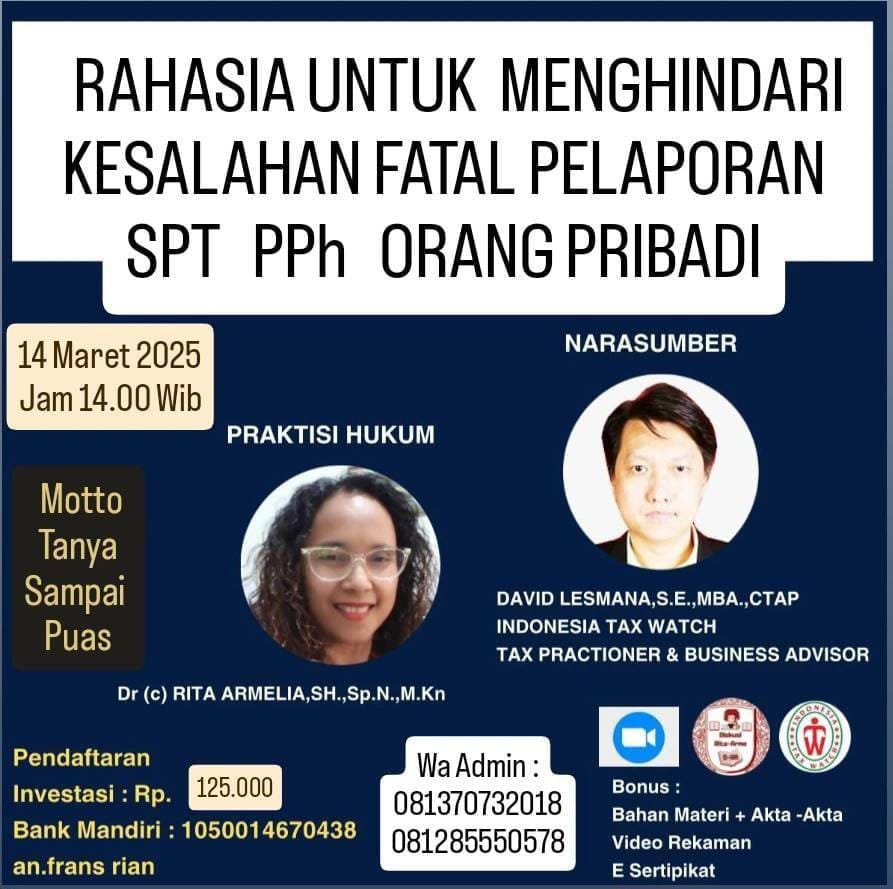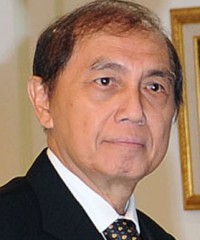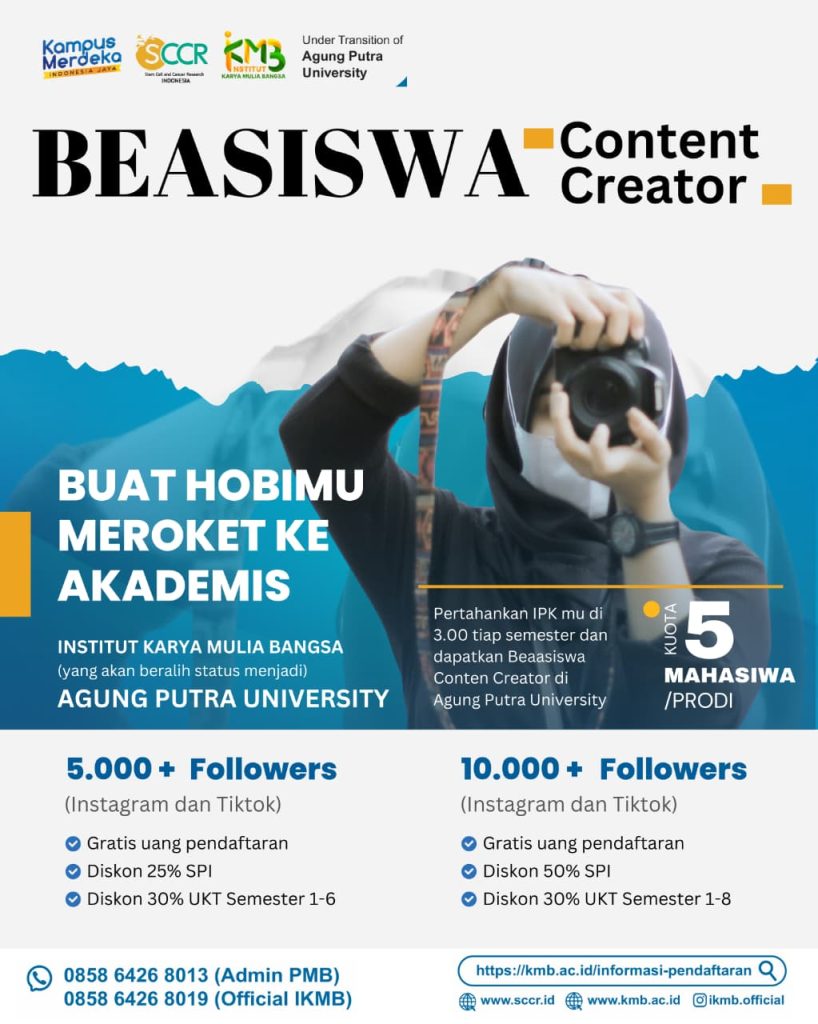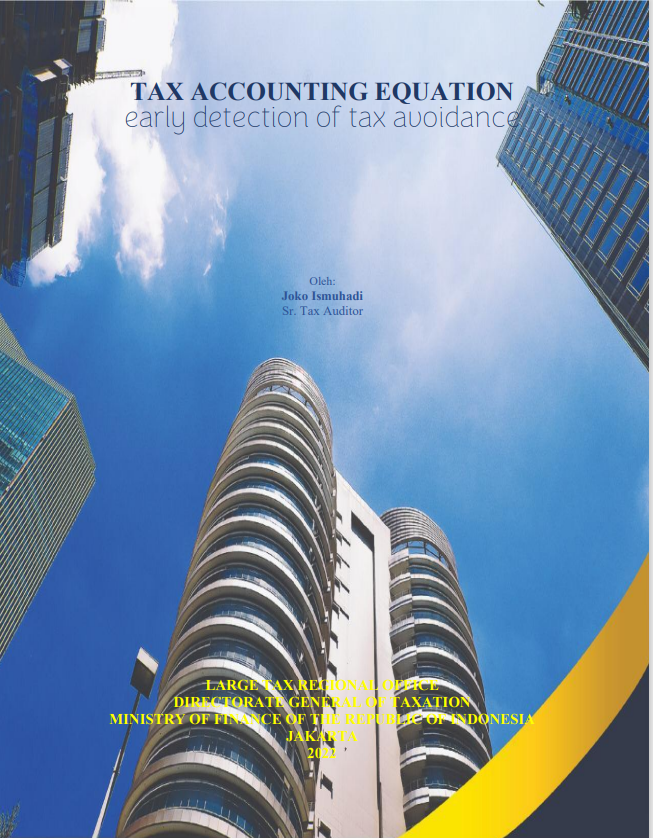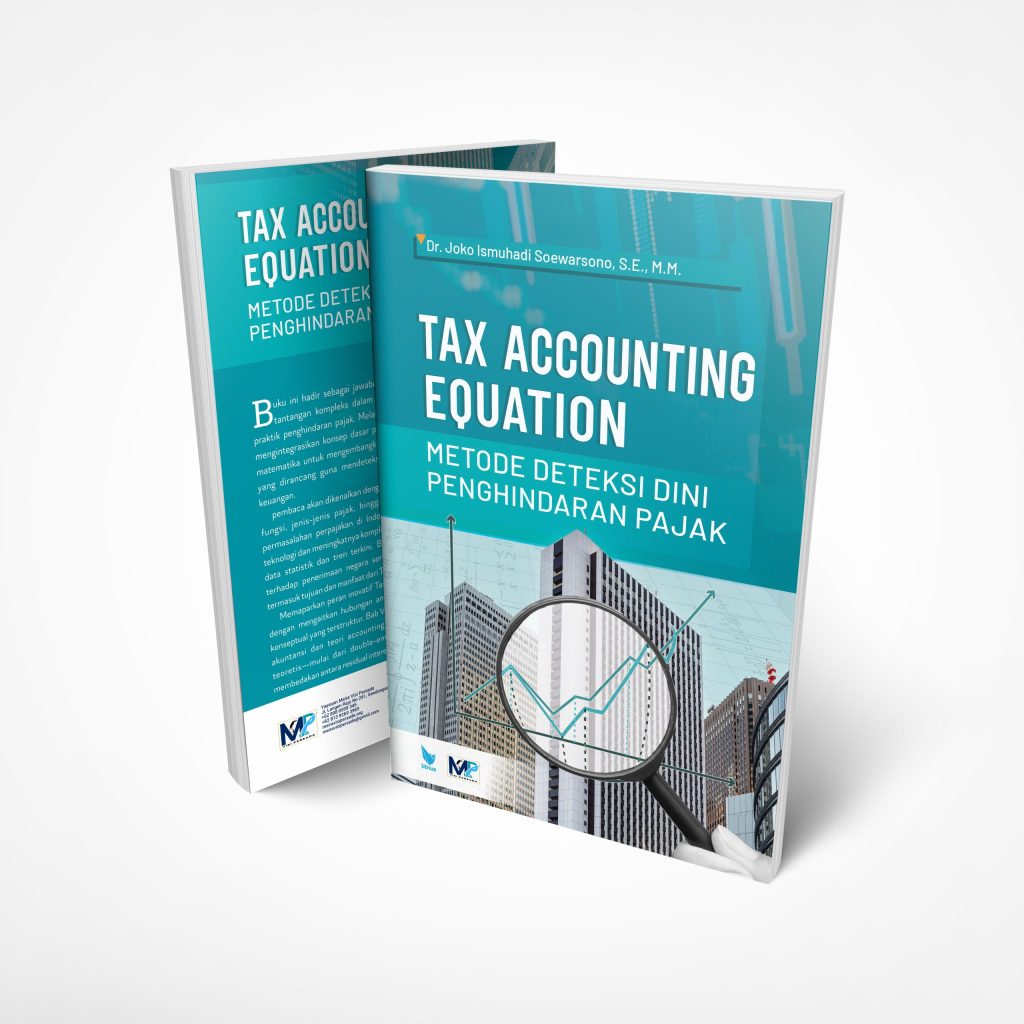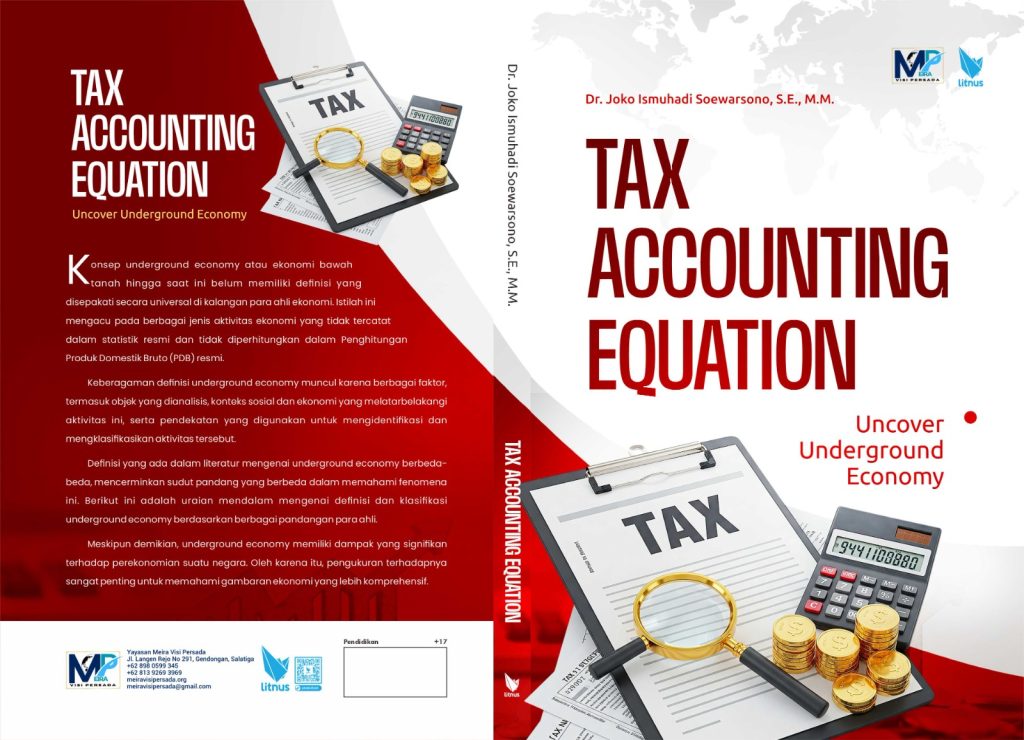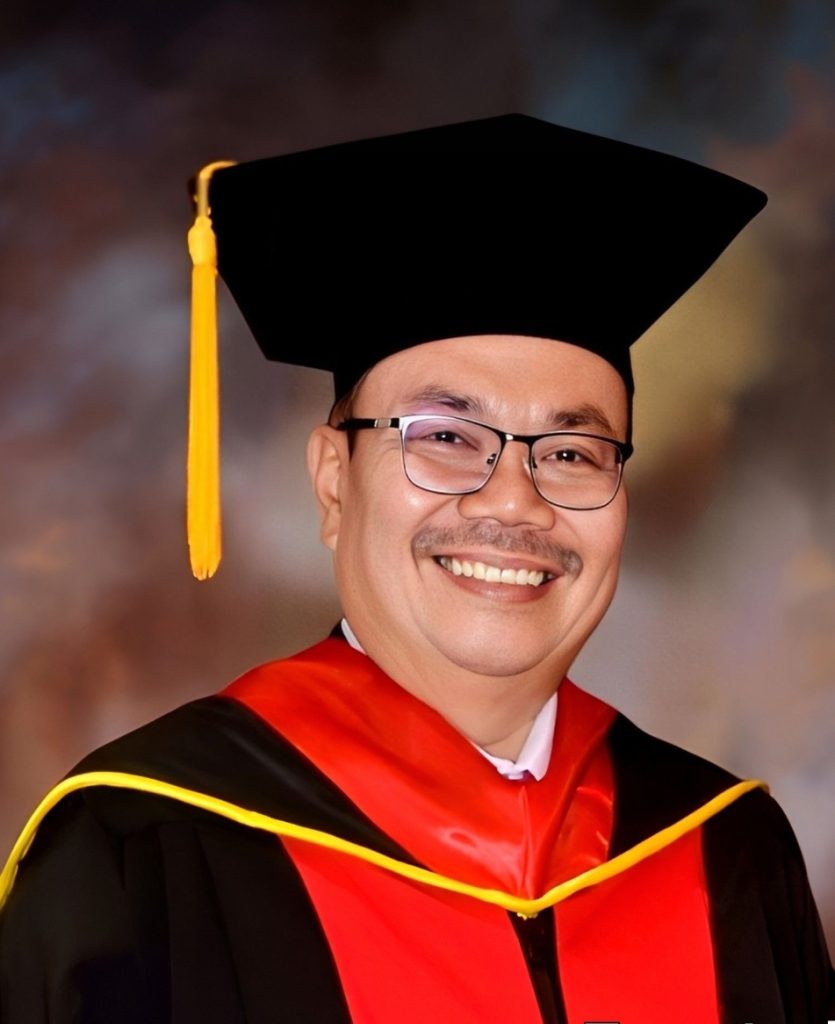
Luca Pacioli’s Basic Accounting Equation and Joko Ismuhadi’s Tax Accounting Equation: A World Legacy in Accounting Science
- Ekonomi
Saturday, 05 April 2025 04:23 WIB
Jakarta, fiskusnews.com:
Introduction: The Enduring Significance of Accounting Science
Accounting, in its essence, serves as the language of business, providing a systematic framework for recording, summarizing, and interpreting financial information. Its significance transcends mere bookkeeping, playing a fundamental role in facilitating economic activity, fostering societal development, and ensuring transparency and accountability in resource management. From the rudimentary tracking of goods in ancient civilizations to the sophisticated financial reporting systems of today, accounting has continually evolved, adapting to the increasing complexity of trade, governance, and technological advancements. This evolution has been marked by the contributions of visionary thinkers and practitioners who have laid the cornerstones of modern accounting principles. This report aims to explore the contributions of two such figures, separated by centuries but united by their impact on the field: Luca Pacioli, often hailed as the father of modern accounting, and Joko Ismuhadi, a contemporary scholar exploring the specialized domain of tax accounting equations. By examining their work within the broader context of accounting science, this analysis seeks to illuminate the enduring legacy of accounting thought and its ongoing adaptation to address the evolving needs of the global economic landscape.
Luca Pacioli: The Dawn of Modern Accounting
Life and Context: The Renaissance and the Rise of Commerce
The intellectual and cultural flourishing of the Renaissance in Italy, spanning roughly from the 14th to the 16th century, provided a fertile ground for advancements in various fields, including mathematics and commerce. This era witnessed a resurgence of interest in classical learning, coupled with unprecedented growth in trade and mercantile activities, particularly in vibrant city-states like Venice and Florence. The increasing scale and complexity of business transactions necessitated more sophisticated methods of financial record-keeping to ensure accuracy, track profitability, and manage burgeoning wealth. It was within this dynamic environment that Luca Pacioli emerged as a pivotal figure. Born around 1447 in Sansepolcro, Tuscany, Pacioli was not only a gifted mathematician but also a Franciscan friar, a combination that reflects the intellectual breadth of the time. His deep understanding of mathematical principles, coupled with his exposure to the practical accounting methods used by Venetian merchants, positioned him uniquely to make lasting contributions to the field. Notably, Pacioli collaborated with Leonardo da Vinci, a testament to the interdisciplinary nature of intellectual pursuits during the Renaissance, where mathematics, art, and practical applications were often intertwined. The flourishing of trade during this period created a demand for improved accounting techniques, and Pacioli’s work directly addressed this need by providing a structured and systematic approach to financial record-keeping.
Summa de Arithmetica, Geometria, Proportioni et Proportionalita: A Foundational Text
Pacioli’s most significant contribution to accounting came in 1494 with the publication of his comprehensive mathematical treatise, Summa de Arithmetica, Geometria, Proportioni et Proportionalita (often referred to simply as Summa). This extensive work, spanning over 600 pages, covered a wide array of mathematical topics, including arithmetic, algebra, and geometry, reflecting the state of mathematical knowledge at the time. While Summa was primarily a mathematics book, its enduring legacy in accounting stems from a particular section titled Particularis de Computis et Scripturis (Details of Calculation and Recording), which meticulously described the bookkeeping methods prevalent among Venetian merchants. The significance of Summa was amplified by the fact that it was one of the first books printed using the Gutenberg press, enabling the widespread dissemination of knowledge to a much broader audience than previously possible. The section on accounting proved to be so influential and in demand that it was later extracted from Summa and published separately, further attesting to its profound impact on commercial practices. By presenting these concepts in the vernacular Italian language, Pacioli made them accessible to merchants and businessmen, not just scholars, thereby facilitating the adoption of more systematic accounting methods in the burgeoning commercial world.
The Codification of Double-Entry Bookkeeping
Luca Pacioli is widely credited with providing the first published and comprehensive description of the double-entry bookkeeping system, a method that was already in use by Venetian merchants but had not yet been formally documented and disseminated. The fundamental principle of double-entry bookkeeping is that every financial transaction affects at least two different accounts, with one account being debited and another being credited for an equal amount. Pacioli meticulously described the use of journals (to record transactions chronologically) and ledgers (to classify and summarize transactions by account) as integral components of this system. He emphasized the crucial importance of ensuring that the total of debits always equals the total of credits, a self-balancing mechanism that enhances the accuracy and reliability of financial records. While Pacioli did not invent the double-entry system, which had been practiced in Venice for perhaps two centuries prior to the publication of Summa, his detailed and systematic explanation of the method served to standardize and disseminate it widely across Europe and beyond. His work provided a clear framework that businesses could adopt to better manage their finances, track their performance, and make informed decisions.
The Basic Accounting Equation: Assets = Liabilities + Owner’s Equity
At the heart of the double-entry bookkeeping system lies the fundamental accounting equation, which Pacioli also documented in Summa. This equation, which remains a cornerstone of modern accounting, states that a company’s total assets are equal to the sum of its liabilities and owner’s equity. The double-entry system inherently ensures that this equation remains in balance because every transaction recorded involves equal debits and credits, which ultimately affect the components of the accounting equation. Assets represent the economic resources owned by a business that are expected to provide future benefit. Liabilities, on the other hand, are the obligations of the business to external parties, representing what the business owes to others. Owner’s equity (also known as capital) represents the residual interest in the assets of the business after deducting liabilities; it is the owner’s stake in the company. While the basic equation is fundamental, it can be expanded to include revenues and expenses, providing a more detailed view of how business operations impact owner’s equity. Nevertheless, the core principle of balance embodied in Pacioli’s documented equation remains the bedrock of accounting.
Pacioli’s Broader Contributions to Accounting Principles and Practices
Beyond the double-entry system and the basic accounting equation, Luca Pacioli’s Summa also introduced or defined several other key accounting concepts and terms that are still in use today. These include the terminology and definitions of assets, liabilities, capital income, and expense accounts. He also described the use of trial balances as a mechanism to verify the equality of debits and credits in the ledger. Furthermore, Pacioli discussed the importance of year-end closing entries to prepare financial statements for a specific period. Notably, his treatise touched upon the significance of accounting ethics, emphasizing the need for honesty and integrity in financial record-keeping. Pacioli is also credited with introducing the Rule of 72, a simple formula for estimating the time it takes for an investment to double given a fixed annual rate of return. While not solely focused on it, his work also contained elements that would later contribute to the development of cost accounting concepts, such as the tracking of costs associated with business operations. The breadth of topics covered in Summa demonstrates Pacioli’s comprehensive understanding of the accounting practices of his time and his ability to synthesize and codify them in a manner that would profoundly influence the future of the discipline.
Joko Ismuhadi: Exploring the Landscape of Tax Accounting Equations
Context: Tax Accounting in the Modern Economic Environment
In the contemporary economic environment, tax accounting has emerged as a specialized and critical field within the broader discipline of accounting. Unlike general financial accounting, which aims to provide a fair and accurate representation of an entity’s financial position and performance to a wide range of stakeholders, tax accounting primarily focuses on ensuring compliance with the intricate and often complex tax laws and regulations established by governmental authorities. While both disciplines deal with financial data, their objectives, principles, and reporting requirements can differ significantly. Tax accounting plays a vital role in enabling governments to collect revenue necessary for public services and in guiding businesses and individuals to understand and fulfill their tax obligations. The increasing sophistication of tax legislation in response to globalization and evolving economic activities has further heightened the importance of tax accounting expertise.
The Concept of a Tax Accounting Equation: Purpose and Potential
In this context, the concept of a tax accounting equation, as explored by contemporary scholars like Dr. Joko Ismuhadi, represents an attempt to apply the fundamental principles of accounting balance to the specific domain of taxation. While the research snippets do not explicitly provide a single, universally accepted formula for Joko Ismuhadi’s Tax Accounting Equation, they highlight its potential as an analytical tool for various purposes within the realm of taxation. Such an equation could potentially be utilized in areas such as enhancing tax compliance by identifying discrepancies, aiding in the early detection of tax fraud and avoidance schemes, and providing insights for economic analysis related to tax revenue and the impact of tax policies. The development of a tax accounting equation suggests an innovative approach to formalizing the relationships between various financial elements from a tax perspective, potentially offering new methodologies for tax administration and enforcement.
Analysis of Dr. Joko Ismuhadi’s Tax Accounting Equation
Based on the available research, Dr. Joko Ismuhadi’s Tax Accounting Equation appears to be primarily utilized as a forensic tool within the Indonesian context, aimed at analyzing tax-related financial data for specific investigative purposes. Several articles highlight its application in uncovering activities within the underground economy in Indonesia, suggesting that the equation helps to reveal hidden or unreported economic transactions that have tax implications. Furthermore, Ismuhadi’s work is presented as a method for the early detection of tax avoidance and/or embezzlement, indicating that the equation might help identify unusual patterns or imbalances in financial data that could signal illicit activities aimed at reducing tax liabilities or misappropriating funds. There is also mention of its potential to analyze and address income tax loopholes within the Indonesian tax system, implying that the equation could help policymakers and tax authorities understand how existing regulations might be exploited and how they could be strengthened. Notably, a discussion on ResearchGate features Joko Ismuhadi discussing the analysis of income tax evasion using a mathematical approach that considers Luca Pacioli’s double-entry bookkeeping principles, suggesting a foundational link between traditional accounting logic and his contemporary work on tax equations.
Academic and Practical Implications of Ismuhadi’s Work
Dr. Joko Ismuhadi’s exploration of a tax accounting equation holds several potential academic and practical implications. Academically, it represents an interesting intersection of accounting principles and tax law, suggesting a formal mathematical approach to understanding and analyzing tax-related financial relationships. This could potentially lead to the development of new theoretical frameworks and analytical tools within the field of tax accounting. Practically, if Ismuhadi’s approach proves effective in the Indonesian context, there is a possibility that it could be adopted or adapted in other countries facing similar challenges related to tax evasion, avoidance, and the underground economy. The ability to formalize tax-relevant financial data into an equation could provide tax authorities with a powerful instrument for early detection, forensic analysis, and policy evaluation. It is important to note that further research and wider dissemination of the specific formulation and validation of Ismuhadi’s Tax Accounting Equation would be necessary to fully understand its broader applicability and impact. Dr. Joko Ismuhadi Soewarsono is affiliated with Padjadjaran University in Indonesia, indicating an academic grounding for his work. His expertise lies in areas such as tax planning, financial engineering, and related financial disciplines, which are directly relevant to the development and application of a tax accounting equation. His work thus represents a contemporary evolution in applying the fundamental logic of accounting equations to the specialized and increasingly important area of taxation.
Comparing and Contrasting Accounting Equations: Basic vs. Tax
Fundamental Principles and Objectives
The basic accounting equation, as established in the framework of double-entry bookkeeping, serves the fundamental objective of representing the financial position of an entity at a specific point in time. It highlights the relationship between an entity’s resources (assets) and the sources of those resources, whether from creditors (liabilities) or owners (equity). In contrast, the objective of a tax accounting equation, based on the work of Joko Ismuhadi, appears to be more focused on analyzing tax-related financial data for specific purposes such as the detection of tax evasion, the identification of loopholes in tax regulations, and the analysis of underground economic activities. While both types of equations deal with financial information, their primary aims diverge: the basic equation provides a comprehensive snapshot of an entity’s overall financial standing, whereas a tax equation targets specific aspects of financial data that are pertinent to taxation and regulatory compliance.
Scope and Application: Financial Reporting vs. Taxation
The basic accounting equation has a broad scope and is a fundamental component of general-purpose financial reporting, used extensively for decision-making by various stakeholders including investors, creditors, and management. It underpins the preparation of key financial statements like the balance sheet. On the other hand, a tax accounting equation, such as the one explored by Ismuhadi, has a narrower scope, focusing specifically on financial items and relationships that are relevant under tax laws and regulations. The application of a tax accounting equation might involve analyzing specific accounts or transactions that have a direct impact on tax liabilities or are indicative of potential tax irregularities. Furthermore, the treatment of certain assets, liabilities, and equity items can differ between financial accounting principles (like GAAP or IFRS) and tax regulations. For example, the depreciation methods allowed for tax purposes might vary from those used for financial reporting. This difference in regulatory frameworks leads to a distinction in how financial elements are classified and valued depending on whether the objective is general financial reporting or tax compliance and analysis.
Potential for Overlap and Divergence
Despite their distinct objectives and scopes, there is a potential for overlap and divergence between the basic accounting equation and a tax accounting equation. Tax liabilities themselves are a component of the basic accounting equation, typically falling under the category of liabilities, representing the amounts owed to tax authorities. The information derived from the basic accounting equation, such as the values of assets, liabilities, revenues, and expenses, can serve as a starting point for calculating taxable income and determining tax obligations. However, tax regulations often prescribe specific rules for the recognition, measurement, and reporting of certain financial items, which can deviate from the principles of general financial accounting. For instance, certain expenses that are deductible for tax purposes might not be recognized as expenses under GAAP until a later period, or vice versa. Similarly, the valuation of assets for tax purposes might differ from their carrying value in financial statements. A tax accounting equation, like Ismuhadi’s, likely incorporates these specific tax rules and considerations, potentially leading to a different formulation or emphasis compared to the basic accounting equation. While the fundamental concept of balance might still apply, the elements included and the relationships between them would be tailored to the specific objectives of tax analysis and compliance.
The World Legacy in Accounting Science: Beyond Pacioli and Ismuhadi
Early Influences on Accounting Thought
The history of accounting science extends far beyond the contributions of Luca Pacioli, with its roots tracing back to the earliest forms of civilization. Ancient societies in Mesopotamia and Egypt developed rudimentary record-keeping systems to track agricultural produce, livestock, and other economic resources. Early forms of auditing systems were also evident in these civilizations to ensure the proper management of resources. During the Roman Empire, detailed financial information was collated by the government. Even before Pacioli, double-entry bookkeeping systems had begun to emerge in different parts of the world, including India (with the bahi-khata system) and the Middle East. These early developments demonstrate that the need for accounting has been a long-standing aspect of human economic activity, with various cultures independently developing methods to track and manage financial affairs.
Key Figures in the Evolution of Double-Entry Bookkeeping
While Pacioli is renowned for his publication on double-entry bookkeeping, it is important to acknowledge that he was not the inventor of the system. Benedetto Cotrugli, for instance, described the principles of double-entry bookkeeping in his treatise Della mercatura e del mercante perfetto as early as 1458, although this work was not published until 1573. Furthermore, the system itself was already in practice among Venetian merchants for a considerable period before Pacioli documented it in Summa. Pacioli’s significant contribution lies in his systematic codification and wide dissemination of this existing practice, making it more accessible and standardized for broader adoption.
The Development of Cost Accounting
The Industrial Revolution in the 18th and 19th centuries brought about significant changes in business operations, leading to the development of specialized areas within accounting. Josiah Wedgwood, an English potter, is often highlighted as a pioneer in cost accounting. In the late 18th century, Wedgwood developed a system to track the costs associated with producing his pottery, including materials, labor, and overheads, to determine the profitability of individual products. His innovative approach laid the foundation for modern cost accounting practices, which are crucial for businesses to manage their production costs, set prices, and make informed decisions about product lines.
The Emergence of Professional Accounting Organizations
The 19th century also witnessed the formalization of the accounting profession with the establishment of the first professional accounting organizations. In Scotland, the Institute of Accountants in Glasgow and the Edinburgh Society of Accountants were founded in 1854, marking a significant step towards recognizing accounting as a distinct profession with its own standards and qualifications. This was followed by the formation of similar bodies in England, such as the Institute of Chartered Accountants in England and Wales. In the United States, the American Institute of Certified Public Accountants (AICPA) was established in 1887 and played a crucial role in shaping accounting standards and practices in the country. The rise of these professional organizations helped to establish accounting as a recognized and respected field, with a focus on ethics, competence, and the development of standardized principles.
Influential Thinkers in Accounting Theory
Beyond the practical aspects of bookkeeping and cost management, the field of accounting also benefited from the contributions of influential thinkers who focused on developing accounting theory. William Paton is considered a highly significant figure in this regard, with his work in the early to mid-20th century profoundly impacting accounting thought. He advocated for innovative approaches to accounting for assets, liabilities, and income, many of which were adopted later as generally accepted practices. Other notable figures who contributed significantly to accounting theory include A.C. Littleton and George O. May. Their writings and research helped to shape the underlying principles and concepts of accounting, moving it beyond a mere record-keeping function to a more sophisticated discipline grounded in theoretical frameworks.
The Historical Context and Enduring Impact of Luca Pacioli’s Work
The Role of Summa in Disseminating Accounting Knowledge
Luca Pacioli’s Summa de Arithmetica holds a unique position in the history of accounting as the first printed work to describe the double-entry bookkeeping system. The advent of the printing press in the mid-15th century was a revolutionary development that allowed for the mass production and wide distribution of books, and Summa was among the early beneficiaries of this technology. This meant that Pacioli’s detailed explanation of double-entry bookkeeping could reach a far wider audience than handwritten manuscripts ever could, contributing significantly to the standardization and adoption of this method across Europe. Summa served not only as an introduction to the principles of double-entry bookkeeping but also as a practical guide for merchants and businessmen, and it became a widely used accounting textbook for decades after its publication. The clarity and comprehensiveness of Pacioli’s work played a crucial role in establishing double-entry bookkeeping as the dominant accounting system for centuries to come.
The Influence of Double-Entry Bookkeeping on Business Practices
The widespread adoption of double-entry bookkeeping, largely facilitated by Pacioli’s Summa, had a transformative impact on business practices during the Renaissance and beyond. By providing a systematic method for recording all financial transactions, double-entry bookkeeping enabled businesses to become more organized, efficient, and profitable. The ability to track both debits and credits for every transaction allowed for a more accurate understanding of a company’s financial position and performance, facilitating better decision-making and resource management. This improved financial clarity also played a crucial role in the flourishing of logistics and trade, as merchants could more confidently engage in complex transactions and long-distance trade knowing their financial records were reliable. Many scholars argue that the development and widespread adoption of double-entry bookkeeping was a key factor in the rise of modern capitalism, providing the essential accounting infrastructure for the growth of complex business organizations and financial markets.
Pacioli’s Legacy in the Development of Modern Accounting Standards (GAAP, IFRS)
The fundamental principles of double-entry accounting, as first codified by Luca Pacioli in Summa, have proven remarkably enduring, remaining largely unchanged for over 500 years. The core concepts of debits and credits, the use of journals and ledgers, and the underlying logic of the accounting equation continue to form the basis of modern accounting systems and standards. Contemporary accounting frameworks such as Generally Accepted Accounting Principles (GAAP) and International Financial Reporting Standards (IFRS) trace their roots back to the structured approach that Pacioli documented. While accounting has evolved significantly in terms of complexity, regulation, and technology, the foundational principles laid out by Pacioli remain integral to the profession. His emphasis on accuracy, transparency, and the balanced recording of financial information continues to guide accountants and shape the way businesses around the world manage and report their financial activities.
Exploring Academic Discussions on Joko Ismuhadi’s Tax Accounting Equation
The work of Joko Ismuhadi on the tax accounting equation is a subject of contemporary academic and professional discussion, particularly within Indonesia. Several articles and online resources analyze his equation for its potential in addressing critical issues within the Indonesian tax landscape, such as detecting tax evasion and uncovering underground economy activities. His publications and research interests, as indicated on platforms like ResearchGate, also revolve around tax and accounting matters in Indonesia, suggesting an ongoing engagement with these topics within the academic community. Furthermore, his participation in discussions on platforms like ResearchGate, where he interacts with other researchers on tax-related subjects, highlights the ongoing academic exploration and debate surrounding his work. While Luca Pacioli’s contributions are firmly rooted in history, Joko Ismuhadi’s tax accounting equation represents a more recent area of academic and practical inquiry, focused on applying accounting principles to the specific challenges of tax administration in the modern context.
Synthesis: The Evolution of Accounting Science and the Contributions of Pacioli and Ismuhadi
Tracing the Lineage of Accounting Thought
The journey of accounting science reveals a fascinating lineage of thought and practice, starting from the early, rudimentary methods of record-keeping in ancient civilizations. Luca Pacioli’s codification of the double-entry bookkeeping system in the 15th century marked a pivotal moment, providing a structured and balanced framework for financial accounting that would lay the foundation for modern accounting principles and practices. Pacioli’s work addressed the needs of a rapidly growing commercial world, offering tools for better financial management and accountability. Centuries later, Joko Ismuhadi’s work on a tax accounting equation represents a contemporary example of how these foundational accounting principles continue to be adapted and applied to address specific challenges in the modern economic landscape, particularly in the specialized area of tax administration. Ismuhadi’s approach seeks to leverage the logic and balance inherent in accounting equations to tackle issues like tax evasion and underground economic activity, demonstrating the enduring relevance and adaptability of accounting thought.
The Interplay Between Financial and Tax Accounting
Financial accounting and tax accounting, while distinct in their objectives and regulatory frameworks, are inherently interconnected. The basic accounting equation provides a fundamental framework for understanding an entity’s financial position, and the data derived from financial accounting often serves as a starting point for tax accounting calculations. However, tax regulations introduce their own specific rules and considerations that can lead to a divergence in the treatment of certain financial items compared to general financial accounting principles. A tax accounting equation, such as the one explored by Ismuhadi, represents a specialized application of the broader principles underlying the basic accounting equation, tailored to the specific rules and objectives of taxation. It highlights how the fundamental logic of accounting balance can be adapted and applied within a specific regulatory context to achieve particular analytical and enforcement goals. Both financial and tax accounting are essential for providing a comprehensive view of an entity’s financial affairs, albeit from different perspectives and with different primary objectives.
The Ongoing Development of Accounting Principles in Response to Economic and Societal Needs
Accounting science is not a static body of knowledge but rather a dynamic field that continuously evolves in response to the changing needs of society and the economy. The emergence of new technologies, the increasing complexity of business practices, and evolving regulatory requirements all drive the ongoing development and adaptation of accounting principles. Pacioli’s work was a response to the burgeoning commerce of the Renaissance, and Ismuhadi’s exploration of a tax accounting equation is a response to the contemporary challenges of tax administration in Indonesia. The field continues to see innovation in areas such as forensic accounting, which applies accounting principles to legal and investigative purposes, and sustainability reporting, which expands the scope of accounting to include environmental and social impacts. Ismuhadi’s work on a tax accounting equation is a testament to this ongoing adaptation and innovation within the field, demonstrating how the fundamental principles of accounting can be creatively applied to address new and evolving economic and societal needs.
Conclusion: Reflecting on the Past, Present, and Future of Accounting Science
Luca Pacioli’s seminal work in codifying the double-entry bookkeeping system laid an enduring foundation for modern accounting. His Summa de Arithmetica not only disseminated essential accounting principles but also shaped business practices for centuries. Today, the basic accounting equation he documented remains a cornerstone of financial understanding. In the present, scholars like Joko Ismuhadi continue to build upon this legacy by exploring innovative applications of accounting principles to address contemporary challenges, such as tax evasion and economic transparency. Ismuhadi’s work on a tax accounting equation demonstrates the ongoing relevance and adaptability of accounting science in tackling specific modern issues. Ultimately, the evolution of accounting science, from Pacioli’s foundational contributions to Ismuhadi’s contemporary explorations, underscores its enduring significance in promoting transparency, accountability, and a deeper understanding of economic activities across the globe. As the world continues to evolve, accounting principles will undoubtedly continue to adapt and innovate to meet the challenges of the future.
Table 1: Key Contributions of Luca Pacioli to Accounting Science
| Contribution | Significance/Impact | Relevant Snippets |
| First published description of double-entry bookkeeping | Foundation of modern accounting systems, standardized accounting practices | |
| Documentation of the basic accounting equation | Fundamental framework for understanding financial position, ensures balance and accuracy | |
| Definition of key accounting terms | Provided a common vocabulary for accounting, including assets, liabilities, capital, income, expenses | |
| Description of journals and ledgers | Established the basic structure for recording and classifying financial transactions | |
| Emphasis on debits equaling credits | Core principle of double-entry system, ensures accuracy and facilitates error detection | |
| Introduction of the trial balance | Method for verifying the accuracy of ledger balances | |
| Discussion of year-end closing entries | Standard procedure for preparing financial statements | |
| Emphasis on accounting ethics | Highlighted the importance of honesty and integrity in financial record-keeping | |
| Introduction of the Rule of 72 | Simple formula for estimating investment growth | |
| Contributions to cost accounting concepts | Early insights into tracking and managing business costs |
Table 2: Potential Applications of Joko Ismuhadi’s Tax Accounting Equation (Based on Available Information)
| Application Area | Description | Relevant Snippets |
| Uncovering underground economy activity | Used as a forensic tool to reveal hidden or unreported economic transactions with tax implications in Indonesia | |
| Early detection of tax avoidance and/or embezzlement | Helps identify unusual patterns or imbalances in financial data that could signal illicit activities aimed at reducing tax or misappropriating funds | |
| Tool for early detection of tax evasion in Indonesia | May help identify discrepancies in financial data that suggest tax evasion | |
| Analysis of potential to address income tax loopholes | May help policymakers and tax authorities understand how existing regulations might be exploited |
Table 3: Notable Figures in the History of Accounting Science (Beyond Pacioli and Ismuhadi)
| Figure’s Name | Key Contribution(s) | Relevant Snippets |
| Benedetto Cotrugli | Earlier description of double-entry bookkeeping (before Pacioli’s publication) | |
| Josiah Wedgwood | Pioneer of cost accounting, developed a system to track costs and profitability of individual products | |
| William Paton | Influential thinker in accounting theory, advocated for innovative accounting practices | |
| A.C. Littleton | Significant contributions to accounting theory | |
| George O. May | Influential figure in the development of accounting principles | |
| William Welch Deloitte | Founder of one of the “Big Four” accounting firms, early advocate for independent auditing | |
| J.P. Morgan | Prominent financier who began his career as an accountant, played a key role in stabilizing American financial markets | |
| Frank J. Wilson | Led the team of IRS accountants who brought down Al Capone for tax evasion, highlighting the significance of forensic accounting | |
| Mary Harris Smith | World’s first woman chartered accountant and female accounting firm owner | |
| Christine Ross | First woman CPA (Certified Public Accountant) in the United States |
Reporter: Marshanda Gita – Pertapsi Muda
Share
Berita Lainnya
Evolusi Luca Pacioli’s Basic Accounting Equation to Dr. Joko Ismuhadi’s Tax Accounting Equation
Implementasi Komprehensif Undang-Undang Nomor 9 Tahun 2017 sebagai Fondasi Badan Penerimaan Negara: Analisis Strategis
Ismuhadi’s Equation: A Forensic Tool for Detecting Tax Avoidance and Underground Economic Activity in Indonesia
KOMISI (Kelas Online akadeMISI): Seri Pajak Internasional Episode 2 bertajuk Isu-Isu Pajak Internasional & Solusinya
[📓Webinar SPT Series Vol.II: Penyusunan SPT Badan untuk Industri Perguruan Tinggi🎓]
digitAl-Capone: Cara Afdol Berantas Judol
Rekomendasi untuk Anda

Berita Terbaru
Eksplor lebih dalam berita dan program khas fiskusnews.com
Tag Terpopuler
# #TAE
# #TAX ACCOUNTING EQUATION
# #TAX FRAUD
# #TAX EVASION

